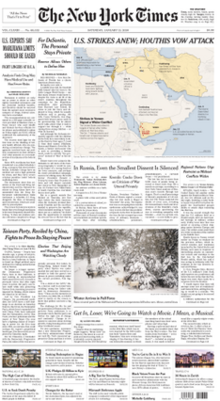Unknown Facts About News Articles
Unknown Facts About News Articles
Blog Article
Rumored Buzz on News Articles
Table of ContentsNot known Details About News Articles The Best Guide To News ArticlesSome Known Incorrect Statements About News Articles See This Report on News ArticlesHow News Articles can Save You Time, Stress, and Money.
Great expertise of various topics gives trainees an one-upmanship over their peers. Also though digital and social networks are conveniently obtainable, we ought to not forget how important it is to check out the papers. Parents have to attempt and instill the behavior of checking out a newspaper as a daily regimen to continue the legacy of the adored print medium.News tales additionally consist of at the very least one of the complying with important qualities loved one to the intended audience: closeness, importance, timeliness, human rate of interest, quirk, or repercussion.
Within these limits, news stories additionally intend to be comprehensive. However, various other aspects are involved, some stylistic and some acquired from the media kind. Among the bigger and extra revered papers, justness and balance is a significant aspect in providing details. Discourse is normally confined to a separate area, though each paper may have a various total angle.
Newspapers with a worldwide audience, for example, tend to make use of a more formal style of composing. News Articles.; typical design guides include the and the US Information Design Publication.
The Definitive Guide to News Articles
As a rule, reporters will not use a long word when a short one will do. Information writers try to avoid utilizing the same word much more than as soon as in a paragraph (in some cases called an "resemble" or "word mirror").
Nevertheless, headings often leave out the topic (e.g., "Jumps From Watercraft, Catches in Wheel") or verb (e.g., "Pet cat woman fortunate"). A subhead (additionally subhed, sub-headline, subheading, subtitle, deck or dek) can be either a subordinate title under the major heading, or the heading of a subsection of the short article. It is a heading that comes before the primary message, or a team of paragraphs of the main text.

Added signboards of any of these types might show up later on in the write-up (especially on subsequent web pages) to entice additional reading. Such signboards are additionally used as pointers to the short article in various other areas of the magazine or website, or as advertisements for the piece in other publication or websites. Common framework with title, lead paragraph (recap in strong), various other paragraphs (details) and call details.
Example of a hard-lead paragraph NASA is recommending another room task. The budget requests roughly $10 billion for the project.
The NASA statement came as the firm requested $10 billion of appropriations for the job. An "off-lead" is the 2nd essential front web page news of the day. The off-lead appears either in the top left edge, or straight listed below the lead on the right. To "bury the lead" is to begin the article with history details or information of additional value Continue to the readers, compeling them to find out more deeply into an article than they ought to have to in order to find the necessary factors.
The Single Strategy To Use For News Articles
Common use is that or more sentences each develop their very own paragraph. Journalists normally explain the company or structure of a news story as an inverted pyramid. The necessary and most intriguing aspects of a tale are placed at the start, with supporting info complying with in order of reducing value.
It permits people to discover a subject to just the deepness that their interest takes them, and without the charge of information or subtleties that they could take into consideration irrelevant, but still making that information readily available to a lot more interested viewers. The upside down pyramid structure also makes it possible for posts to be cut to any kind of arbitrary length during format, to fit in the space available.
Some writers start their tales with the "1-2-3 lead", yet there are several kinds of lead readily available. A kicker can refer to several things: The last story in the information program; a "happy" tale to end the program.
Longer articles, such as publication cover write-ups and the pieces that lead the inside sections of a paper, are called. Function tales differ from straight news in several means. Foremost is the absence of a straight-news lead, a lot of the moment. Rather than supplying navigate here the significance of a story up front, function authors may attempt to draw visitors in.
See This Report on News Articles
A function's first paragraphs usually associate an appealing moment or event, as in an "unscientific lead". From the particulars of a person or episode, its sight rapidly expands to abstract principles regarding the story's subject.

The Editor's Toolbox: A Reference Overview for Beginners and Professionals (2001) Allan M. Siegal and William G. Connolly. The New York Times Manual of Style and Usage: The Official Design Overview Made Use Of by the Writers and Editors of the World's The majority of Reliable Newspaper (2002) M. L. Stein, Susan Paterno, and R.
Report this page